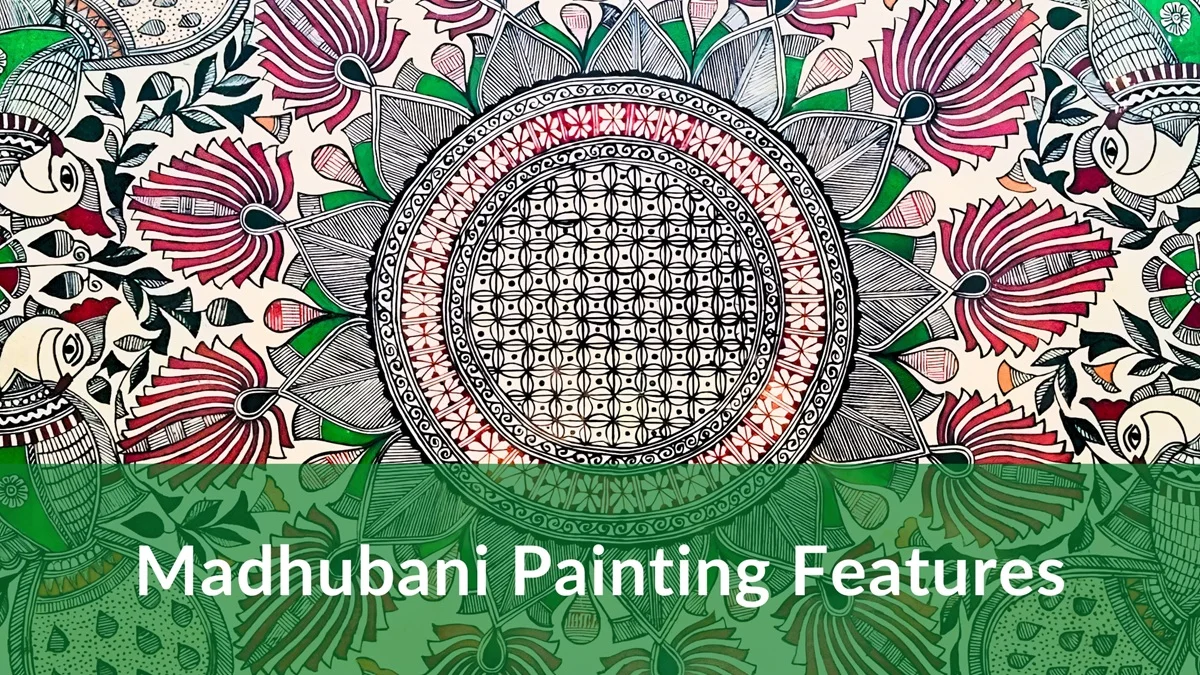
Unique Features & Aesthetics of Madhubani Painting
Imagine a canvas dancing in vibrant hues. Indigenous reds, earthy greens, and radiant yellows unfolding in a dazzling display of flowers, animals, and hypnotic geometric patterns that echo the rhythms of nature. This is the enchanting world of Madhubani painting.
While the names “Mithila” and “Madhubani” may not be familiar to everyone, this age-old art form from the heart of Bihar, India, has long enchanted art enthusiasts across the globe.
Rooted in tradition, Madhubani painting intertwines elements of nature, mythology, folklore, and spirituality. The ornate floral motifs, stylized animal figures, and mesmerizing geometric designs all draw inspiration from the local environment, creating a narrative that is both strikingly beautiful and deeply symbolic.
In this article, we’ll explore the unique features and visual elements that make Madhubani painting such a fascinating art form.
The Different Styles of Madhubani Painting
Madhubani art has many different styles, each with its own unique characteristics and cultural associations.
The Bharni style is known for its bright, jewel-toned colors, and frequent depictions of Hindu deities and celestial beings. In contrast, the Katchni style places a greater emphasis on intricate line work and detailed drawing, with usually a monochromic or two-color palette.
The Tantrik style incorporates spiritual and mystical themes, drawing inspiration from esoteric Hindu traditions. These paintings feature symbolic diagrams, sacred geometry, and representations of deities and ritual objects.
The Godna style, meanwhile, takes inspiration from traditional tattoo designs, using a bamboo pen to render natural motifs like animals, plants, and flowers. This intimate, embodied artistry translates the ancient practice of tattooing onto the canvas.
And then there’s the Kohbar style, closely tied to wedding rituals and ceremonies. These paintings, adorning the walls of the bride and groom’s rooms, feature auspicious symbols, lush floral motifs, and depictions of the couple themselves. The imagery is meant to bless the union and invoke fertility and prosperity.
Apart from these distinct styles, many Madhubani artists also experiment by blending techniques or incorporating their own creative flavors.
The Techniques Used in Madhubani Art
At the heart of Madhubani painting lies a rich tradition of simple yet delicate techniques, passed down through generations of skilled practitioners, often women, who would adorn the mud walls and floors of their homes with elaborate designs.
Rather than relying on brushes, these artists would use pointed bamboo twigs as their tools, dipping them into pigments derived from nature: flowers, leaves, burnt barley seeds, and even cow dung. The resulting colors, earthy and vibrant, would then be carefully applied to build up mesmerizing patterns and motifs.
This hands-on, organic approach lends Madhubani paintings an authentically handcrafted quality, each work a unique tribute to the artists’ intimate connection with their materials and the natural world around them.
With Madhubani painting gaining popularity, artists are now using modern art materials like synthetic paints and brushes. Yet many traditional artists have steadfastly maintained the original techniques, preserving the integrity of this centuries-old art form.
The Unique Visual Elements of Madhubani Painting
Beyond the different stylistic approaches that define Madhubani art, the paintings are also renowned for their captivating visual characteristics and aesthetics. These distinguishing elements work in harmony to create a truly mesmerizing and symbolically rich artistic experience.
Let’s go deeper into the key features that make Madhubani painting unlike others.
Decorative Borders
Madhubani paintings are famed for their detailed, decorative borders that frame the central imagery. These borders are often filled with repeating geometric patterns or floral motifs. The borders serve to contain and accentuate the lively scenes depicted within.
Double Outline
A distinguishing technique used in Madhubani art is the application of a double outline. Artists will first draw the basic shapes and forms in a thin, dark line. They then reinforce this outline with a thicker, bolder line. This creates a sense of depth and definition, making the figures and patterns stand out.
Geometric Patterns
Geometric shapes and patterns are a key attribute of Madhubani painting. Triangles, squares, rectangles, and other angular and even circular forms are skillfully arranged to create mesmerizing designs. These patterns are not just decorative–they also hold symbolic meaning, representing elements of nature, spirituality, and the cosmos.
Mix of Solid & Pattern Fill
In addition to the beautiful patterns that cover the entire canvas, Madhubani artists also skillfully incorporate solid color fills within the various shapes and images. This strategic use of both patterned and solid color elements creates a dynamic and visually striking contrast.
Nature-Inspired Motifs
The natural world is a constant source of inspiration for Madhubani artists. Flowers, animals, trees, and other elements from the local environment are meticulously rendered, often with a stylized, abstract quality. These nature-based motifs reflect the deep connection between the art form and the surrounding landscape.
Vivid Colors & Natural Pigments
Madhubani paintings, particularly the Bharni and Kohbar styles, are known for their use of colors derived from natural sources. The artists skillfully blend and layer these organic hues to create a rich, luminous palette that brings the imagery to life.
Elongated, Expressive Eyes
One of the most distinctive elements of Madhubani art is the depiction of elongated, almond-shaped eyes to all life and divine forms. These exaggerated eyes are not only aesthetically striking, but they also convey a sense of emotion and spirituality. The eyes are often outlined in bold, dark lines to make them the focal point of the figures.
Mythological Themes
Madhubani painting has deep roots in Hindu mythology and spirituality. Many of the artworks depict scenes from ancient epics like the Ramayana and Mahabharata, as well as images of deities, celestial beings, and mythical creatures. These mythological elements infuse the paintings with a sense of cultural significance and timelessness.
Two-Dimensional Imagery
Madhubani paintings are characterized by a flattened, two-dimensional perspective. Rather than using techniques like shading or perspective to create depth, the artists rely on the strategic placement of patterns, colors, and symbolic elements to convey a sense of space and movement.
No Empty Spaces
A complete lack of empty space another important characteristic of Madhubani Paintings. Every inch of the canvas is filled with patterns, motifs, and designs, creating a visually captivating and immersive experience for the viewer.
A Gateway to Timeless Human Expression
From the vibrant, nature-inspired color palettes to the intricate geometric patterns and exaggerated, emotive eyes, each element of a Madhubani work captivates the senses and speaks to the universal human experience.
Madhubani paintings’ increasing popularity serves as a powerful testament to the enduring power of cultural traditions and the ability of art to transcend boundaries. Through its unique aesthetics and deep-rooted symbolism, this enchanting art form invites us to reconnect with the timeless wellsprings of creativity that flow through us all.
Don’t miss your chance to experience the captivating essence of Madhubani painting!

